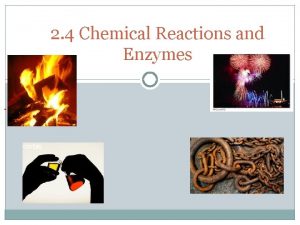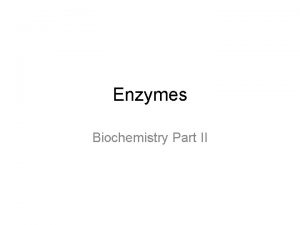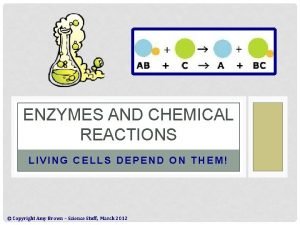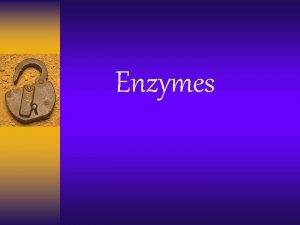An Introduction to Enzymes and Chemical Reactions Enzymes













- Slides: 13

An Introduction to Enzymes and Chemical Reactions

Enzymes: • Catalyst: • A substance that speeds up the rate of chemical reactions. • It lowers the activation energy required for the reaction to occur. • Enzymes: • Proteins that act as biological catalysts. • Cells use enzymes to speed up chemical reactions that take place in the cell.

Lock and Key Model • When you go home at night and the door is locked, can it open itself or can you use a different key • Of course NOT! • Enzymes work in the same way. Enzymes complete very specific jobs and do nothing else. • Enzymes are the specific locks • The compounds they work with are the keys!

Enzyme Action: • For a chemical reaction to take place, the reactants must collide with enough energy so that the existing bonds will be broken and new bonds will be formed.


Enzyme-Substrate Complex: • Enzymes provide a specific binding site where reactants can be brought together to react. • The reactants are known as substrates. Substrate Enzyme

The active site changes shape and forms the enzyme-substrate complex, which helps chemical bonds in the reactants to be broken and new bonds to form. The active sites are the key holes! The substrates are the keys!

Regulation of Enzyme Activity: • Enzymes can be affected by: • 1. p. H – can change enzymes’ shape • 2. Temperature- can change enzymes’ shape and cause them not to work • 3. Activators – make enzymes work faster • 4. Inhibitors – slow down or stop activity

More Enzyme Facts • Each type of enzyme catalyzes only ONE type of reaction • Each enzyme can catalyze thousands of the same reaction every minute!

Naming Enzymes • The first part of the name comes from the substrate that the enzyme binds with. • Always ends in –ASE!!! • Example: Substrate = sucrose Enzyme’s Name=sucrase

How do enzymes work? • 1. Enzyme and a substrate are in the same area • 2. The enzyme grabs onto the substrate with the active site • 3. Catalysis occurs – when the substrate is changed into something new. • 4. The enzyme lets go and returns to normal – the substrate is no longer the same. The substrate is now called the product

Siamese Cats How do Siamese cats relate to enzymes? Discuss with your group and write down your answers you should have at least three answers.

• Warm Bodies, Cool Faces • Because the heart, other organs and muscles create natural warmth in the torso and legs of a Siamese cat, evolution made those parts of its body white to reflect additional heat from sunlight. Areas farther from the warmer heart and torso and with smaller muscles have a harder time staying warm, so those areas are darker to retain more heat. But unlike human skin color, which may darken and lighten many times over the course of a lifetime, Siamese color tends to stabilize shortly after birth. • Heat Regulation • Darker colors retain more heat, and lighter colors reflect heat. Humans produce melanin that darkens their skin if they live in areas that expose them to more sunlight. The darker skin reflects more of the sunlight to keep a person cooler. In a similar way, cats have a gene that allows their skin and fur to darken in the parts of their bodies that need to retain more heat, their extremities.
 Section 2 classifying chemical reactions worksheet answers
Section 2 classifying chemical reactions worksheet answers Section 2 classifying chemical reactions
Section 2 classifying chemical reactions Section 2-4 chemical reactions and enzymes
Section 2-4 chemical reactions and enzymes What is released or absorbed whenever chemical
What is released or absorbed whenever chemical Section 2-4 chemical reactions and enzymes
Section 2-4 chemical reactions and enzymes What is the role of enzymes in chemical reactions
What is the role of enzymes in chemical reactions Enzyme catalyzed reaction
Enzyme catalyzed reaction Types of reactions
Types of reactions Chemical reactions section 1 chemical changes
Chemical reactions section 1 chemical changes Chapter 18 chemical reactions balancing chemical equations
Chapter 18 chemical reactions balancing chemical equations Balancing redox reactions in acidic solution
Balancing redox reactions in acidic solution Chemistry unit 5 reactions balancing reactions worksheet
Chemistry unit 5 reactions balancing reactions worksheet Reactants and products
Reactants and products Chapter 8 review chemical equations and reactions section 2
Chapter 8 review chemical equations and reactions section 2

























